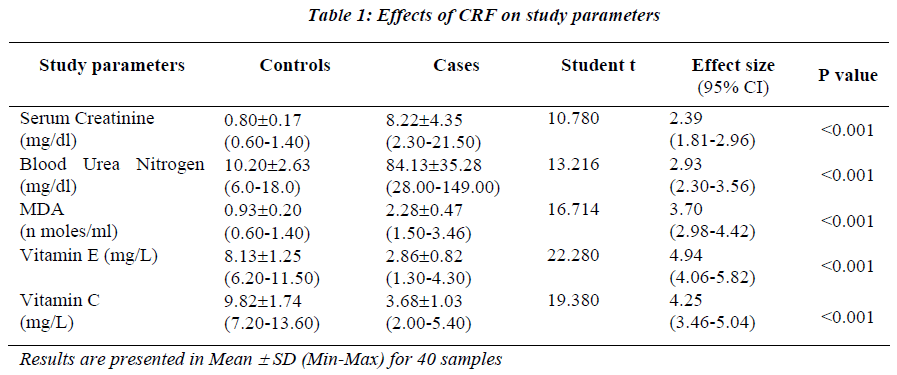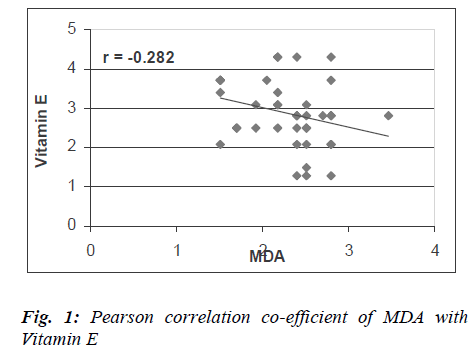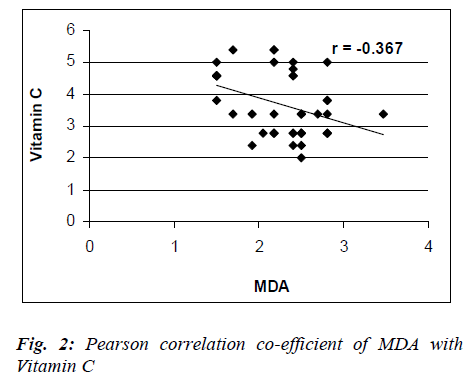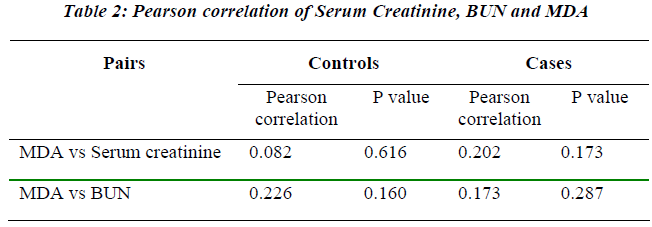- Biomedical Research (2009) Volume 20, Issue 1
Antioxidant vitamins in chronic renal failure
Ratna Priya* and Vasudha K. C.Department of Biochemistry, M.S.Ramaiah Medical College, MSR Nagar, Mathikere, Banglore, India.
- *Corresponding Author:
- Ratna Priya
Department of Biochemistry, M.S. Ramaiah Medical College
MSR Nagar, Mathikere, Banglore 560 054, India
e-mail: viky_chandan@yahoo.com
Accepted date: January 18 2009
Abstract
Reactive oxygen species (ROS) play a significant role in pathogenesis of chronic renal failure (CRF) , leading to damage to protein, lipid and DNA.. The present paper focuses on the extent of free radical damage on lipid (measured as malondialdehyde, MDA) and effect on antioxidant defense mechanism (measured as vitamin E and vitamin C in the serum of CRF patients predialytically. The study was done at M.S.Ramaiah Medical Teaching Hospital, Bangalore, between October 2005 to june 2006.40 cases and 40 controls between age group of 25 - 60 were taken. Lipid peroxidation was measured in terms of MDA and antioxidant were measured as vitamin E and Vitamin C in serum of CRF patients before dialysis. The level of MDA, creatinine, blood urea nitrogen was significantly increased, antioxidant vitamin levels were decreased in CRF patients as compared to normal subjects. The elevation of ROS can lead to lipid peroxidation with progressive renal failure and also promote the complication of CRF. These patients can be supplemented with antioxidant vitamins for preventing lipid peroxidation and occurance of complica-tion.So, supplemention with antioxidant vitamins serves as a method of preventing oxidative stress among patients with renal disease
Keywords
Antioxidant vitamins, chronic renal failure, MDA, oxidative stress
Introduction
Chronic renal failure (CRF) is defined as the renal injury of a more prolonged nature which often leads to progre-ssive and irreversible destruction of nephron mass [1]. Though the incidence of chronic renal failure (CRF) or kidney disease is not as common as coronary heart disease, because of the population density and lack of adequate health care to match, there is a constant clamor for Dialysis and treatment facilities in India. Long term care for kidney disease continues to be expensive. For every one million population about 150 new cases of CRF occurs in India annually and for the country’s one billion population there would be 1,50,000 new cases every year. In United states more than 300,000 people are treated for it annually, a number that has doubled since 1989, accor-ding to the U.S. Renal Data Survey.
Chronic renal failure (CRF) is a pro-oxidant state, charac-terized by increased levels of free radicals, which are involved in progressive renal injury [2]. Reactive oxygen species play a significant role in the pathogenesis of many chronic diseases such as diabetes mellitus, cancer, chronic renal failure etc [3].Oxidative stress is imbalance between ROS generation and antioxidant system that scavenge or reduce ROS concentration. Redox imbalance caused by increased ROS production and/ or reduced antioxidant reserve, leading to pathological consequences including damage to proteins, lipids and DNA.
Antioxidants are first line defense against free radical damage and are critical for maintaining optimum health and well being. Supplementation of antioxidant vitamins (vitamin C and vitamin E) has been recommended for the prevention and treatment of CRF [4]. In this study, the extent of free radical- mediated damage on lipids ( measu-red as MDA levels) and effect on antioxidant defense mechanism(measured as vitamin C and vitamin E) was studied in CRF patients before dialysis to show the role of antioxidant in preventing the progression of CRF and for monitoring and optimization of antioxidant therapy.
Materials and Methods
The blood samples for the present study were collected from Nephrology department, M.S. Ramaiah Medical Teaching Hospital, Bangalore. The healthy volunteers who come for blood donation served as controls. The cases were 40 CRF patients, age 25-60 years,having inclusion criteria of serum creatinine more than 2mg/dl predialytically. The exclusion criteria were patients with no clinical or laboratory evidence of diabetes mellitus, liver diseases, lupus nephritis, acute illness, respiratory diseases. None of the patients had history of antioxidant vitamin supplementation. They were 40 healthy volunteers from blood bank of age 25-60 years of either sex who served as controls.
Informed consent was obtained from each patient before sample collection. The study was approved by medical education council at M.S.Ramaiah medical teaching hospital, Bangalore. From each patient 5 ml blood was collected before dialysis in sterile vacutainer without adding any additives and then centrifuged. The resulting serum was used for studies.
The creatinine and blood urea nitrogen (BUN) were estimated by an autoanalyzer DADE-DIMENSION® clinical chemistry system which employs a modification of the kinetic Jaffe’s reaction reported by Larsen[5] and urease glutamate dehydrogenase coupled enzymatic technique according to Talke H and Schubert [6] respectively. The serum malondialdehyde estimation was done by method described by Wilbur et al [7]. The vitamin E was estimated colorimetrically by a method using α, ά dipyri-dyl and ferric chloride [8]. Vitamin C levels were determ-ined after derivatization with 2,4- dinitrophenylhydrazone (DNPH) [9]. The statistical software namely SPSS 11.0 and Systat 8.0 were used for the analysis of the data and Microsoft Word and Excel have been used to generate graphs, tables etc.
Results
The level of serum creatinine, BUN, MDA, vitamin E and vitamin C are presented in Table 1. The level of serum creatinine, BUN and MDA are significantly higher in cases when compared to controls. The levels of vitamin E and vitamin C are significantly lower in cases as compa-red to controls.
The correlation between serum creatinine, BUN and MDA with vitamin E and vitamin C are shown in figure1 & 2. Both vitamin E and vitamin C correlates negatively with serum creatinine, BUN and MDA.
The correlation between serum creatinine, BUN and MDA is represented in table 2. Serum creatinine and BUN correlates positively with MDA.
Discussion
There is association between increased levels of MDA and progression of renal insufficiency. MDA estimation is one of the most commonly used method for monitoring lipid peroxidation in biological samples. The renal source of reactive oxygen species(ROS) are vascular, glomerular and tubular cells. Circulating infiltrating cells (granulo-cyte-monocyte-macrophage) and platelets present in infla-mmatory renal processes also produce large amount of ROS. Different cellular enzymes including mitochondrial oxidase, lipoxygenase, cycloxygenase, myeloperoxidase, NADPH oxidase, xanthine oxidase, NO synthase have been identified as cellular sources of ROS formation [10]. ROS causes increased lipid peroxidation. In this study level of MDA in serum of CRF is higher than control. Increased concentration of MDA have been reported in plasma of hemodialyzed patient[11].
The non enzymatic antioxidant system protect against oxidative stress. Changes in the levels of these antioxidants reflects their consumption during acute oxidative stress. Hydrophilic and lipophilic antioxidant vitamins are altered in uremia [12]. Vitamin E and Vitamin C interact invitro and vitamin C recycle α-tocopherol from its oxidized form to native form. Vitamin E suppress oxidative stress and retards kidney failure[13].Vitamin E is located both intra and extracellularly and present in cellular membrane and plasma lipoprotein. It is an effective chain breaking antioxidant. Benefecial effect of α-tocopherol (500mg/day during 6 months) supplementation [14] include, a) oxidative state improve-ment, b) Anemia correction, c) atherosclerosis prevention. LDL oxidisability observed in HD patients has been reduced significantly after oral vitamin E supplementation [15]. Vitamin E therapy is also considered as means of correcting plasma antioxidant status and attenuating the cardiovascular disease that accompanies kidney failure [16].
Vitamin C act as chain breaking antioxidant. A study shows the sera of uremic patients has low levels of ascorbic acid [17].Supplementation of Vitamin C allevia-tes oxidative stress and renal cell injury[18]. CRF is associated with impaired endothelium dependent vaso-dilation and accelerated atherogenesis. ROS modify endo-thelial function in renal failure and it is found that vitamin C reduces oxidative stress in CRF and improves NO- mediated resistance vessel dilation[19]. Vitamin C pre-vents apoB fragmentation & inhibits conjugate dienes for-mation during LDL oxidation [20].
From the present study, it is established that CRF is associated with oxidative stress as evidenced by increase in MDA level with decrease in antioxidant vitamins because of their overconsumption or loss in urine. Further study is needed on a large sample size for better under-standing of the concept so that supplementation of anti-oxidant vitamins may be helpful in preventing oxidative stress and related complication in chronic renal failure patients.
Acknowledgements
I am grateful to Dr. Vanitha Gowda, assistant professor, Department of Biochemistry, M.S. Ramaiah Medical College, Bangalore, who helped me in standardization of Vitamin E & Vitamin C and Mr. K.P. Suresh, Scientist, National institute of Physiology, Bangalore, for statistical analysis.
References
- Michael J, Barry L, Brenner M. Chronic renal failure. Chapt. 271. Harrisons?s Principle of Internal Medicine, 14th ed. McGraw Hill Companies, 1998.Vol. 2: 1513pp.
- Westhuyzen J, Adams CE, Fleming SJ. Evidence for oxidativestress during in vitro dialysis. Nephron 1995; 70: 49- 54.
- Maxwell B. Reactive oxygen species in living system ? source, biochemistry and role. American Jour of Med 1991,vol 9; (supplement 3C) : 114-122.
- Hegbrant J, Chen J, He J, Lorraine Gogden, Vecihi Batuman, Paul.K. Vitamin C and E as antioxidants in haemodialysis patients. Int J Artif Organs 1999; 22: 69- 73.
- Larsen K. Creatinine assay by reaction kinetic approach. Clin.Chem.Acta.1972; 41: 209- 217.
- Talke H, Schubert GE. Enzymatische Harnst off bestimmung in Blut and serum In optischer test nach warburg. Klin . W . S. Chr 1965 Feb 1; 43: 174-175.
- Wilbur KM, Bernheim P, Shapiro OW. The TBARs reagent as a test for the oxidation of unsaturated fatty acids by various reagents.. Arch Biochem Biophy 1943; 24: l305-1313.
- Baker H, Frank O. Determination of serum toopherol. ClinicalVitaminology 1968; 172 pp.
- Omaye ST, Turnbull JD and Sauberlich HE. Selected methods for the determination of ascorbic acid in animal cells, tissues and fluids. Methods in enzymology 1979; 62: 1-16.
- E Nigel Wardle. Cellular oxidative process in relation to renal disease. Am J Nephron 2005; 25: 13 -22.
- Baliga R, Ueda N, Shah SV. Oxidant mechanism in glomerular disease. In : Current Nephrology , Gonick , H C ed. St. Louis: Mosby Year Book 1997; 20: 35-151.
- Giardini O, Lubrano R, Galluci T. Effects of alpha tocopherol administration on red blood cell membrane lipid peroxidation in haemodialysis patient. Clin Neph- rol 1984; 21: 174-177.
- Gorgum M, Erdogan D, Abban G, Turkozkan N, Elbeg S. Effects of vitamin E on Adriamycin- induced neph- rotoxicity at the ultrastructural levels in guinea pigs. Nephron 1999; 82: 155-163.
- Cristol JP, Bosc JY, Badiou S, Leblanc M, Lorrho R. Erythropoitein and oxidative stress in haemodialysis: Beneficial effects of vitamin E supplementation. Neph- rol Dial transplant 1997; 12: 2312-2317.
- Islam KN, O?Byrne D, Devaraj S, Palmer B, Grundy SM, Jialal I. Alpha- tocopherol supplementation dec- reeeases the oxidative susceptibility of LDL in renal failure patients on dialysis therapy. Atherosclerosis 2000; 150: 217-224.
- Michael J Fryer. Vitamin E as a protective antioxidant in progressive renal failure. Nephrology 2000;5 (1-2) :1-7.
- Bakaev VV, Efremov AV, Tityaev II. Low level of dehydroascorbic acid in uraemic serum and partial correction of dehydroascorbic acid deficiency by hemodialysis. Nephrol dial transplant 1999; 14: 1472 -1474.
- Frei B, England L, Ames B N. Ascorbic acid is an outstanding antioxidant in human blood plasma. Proc. Natl. Acad. Sci USA 1989; 6: 6377- 6381.
- Cross JM, Donald AE, Nutall SL, Deanfield JE, Wool-fson RG, Macallister RJ. Vitamin C improves resist- ance but not conduit artery endothelial function in patient with chronic renal failure. American Journal Kidney Disease 2000; 63: 1411-1442.
- Scaccini C, Jialal I, Chiesa G. A critical assessment of the effect of aminoguanidine and ascorbate on the oxidative modification of LDL, evidence for interfe- rence with some assay of lipoprotein oxidation by aminoguanidine. J. lipid Res 1994; 35: 1085-1092.



